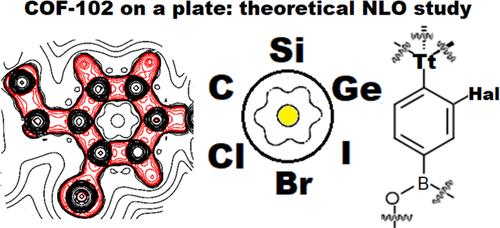Covalent Organic Frameworks in Computational Design of Second-Harmonic Generation Materials: Role of Tetrel Atoms and Their Interactions
IF 2.7
2区 化学
Q3 CHEMISTRY, PHYSICAL
引用次数: 0
Abstract
Modern approaches to the design of nonlinear optical materials often rely on computational techniques. Here, we discuss the effects of the variation in the center tetrel atoms, Tt = C, Si, or Ge, in a series of covalent organic frameworks of the COF-102 family. The effects of halogen substitution, Hal = Cl, Br, or I on intramolecular tetrel bonding are also discussed. The characteristics of the calculated electron density have been implemented to describe the features of the electron distribution around the central fragment involving a tetrahedral tetrel atom. The effect of the central Tt atom leads to a dramatic change in the character of electron delocalization on the Tt–Car bond with aromatic rings. The location of the halogen atom at the ortho-position of the aromatic ring leads to the formation of tetrel bonds, halogen bonds, or other noncovalent interactions. The changes in the second-order electric susceptibility χ(2) have been studied in order to describe the strength of nonlinear optical properties within the periodic couple-perturbed Kohn–Sham approach. A counterintuitive trend for the χ(2) decrease is observed upon substitution of H > Cl > Br > I at the ortho-position of the phenyl ring. This is due to the corresponding elongation of the Tt–Car bond.

二次谐波发生材料计算设计中的共价有机框架:四元原子及其相互作用的作用
设计非线性光学材料的现代方法通常依赖于计算技术。在此,我们讨论了 COF-102 系列共价有机框架中中心四原子(Tt = C、Si 或 Ge)变化的影响。我们还讨论了卤素取代(Hal = Cl、Br 或 I)对分子内四原子成键的影响。计算得出的电子密度的特征被用来描述涉及四面体四原子的中心片段周围的电子分布特征。中心 Tt 原子的影响导致带有芳香环的 Tt-Car 键上的电子析出特征发生了巨大变化。卤素原子位于芳香环的正交位置会导致形成四元键、卤素键或其他非共价相互作用。为了在周期性耦合扰动 Kohn-Sham 方法中描述非线性光学特性的强度,我们对二阶电感应强度 χ(2) 的变化进行了研究。当在苯环的正交位置取代 H > Cl > Br > I 时,χ(2)下降的趋势与直觉相反。这是由于 Tt-Car 键相应地延长了。
本文章由计算机程序翻译,如有差异,请以英文原文为准。
求助全文
约1分钟内获得全文
求助全文
来源期刊

The Journal of Physical Chemistry A
化学-物理:原子、分子和化学物理
CiteScore
5.20
自引率
10.30%
发文量
922
审稿时长
1.3 months
期刊介绍:
The Journal of Physical Chemistry A is devoted to reporting new and original experimental and theoretical basic research of interest to physical chemists, biophysical chemists, and chemical physicists.
 求助内容:
求助内容: 应助结果提醒方式:
应助结果提醒方式:


